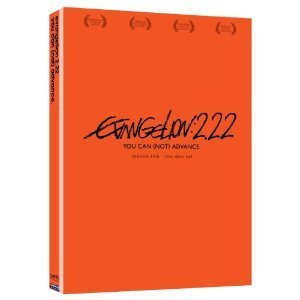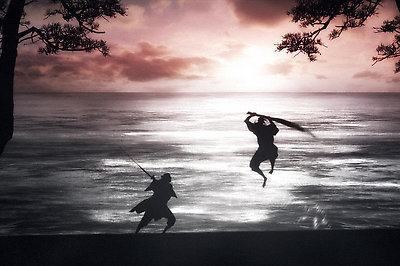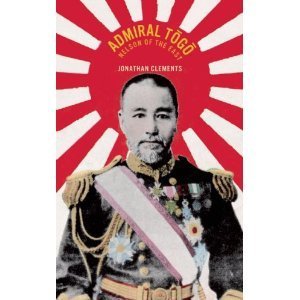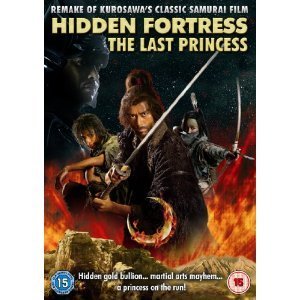Jonathan Clements's Blog, page 18
July 21, 2011
Evangelion 2.22 review
 A decade into an apocalyptic war against alien invaders called "the Angels", Shinji Ikari is one of several young pilots co-opted into the last-ditch Evangelion programme – an ethically-unsound bioweapons project to fight the aliens with their own technology, no matter what the human cost. Behind the scenes, there are scandals within scandals about the cores of the "Eva" units, while the pilots bicker and squabble, and fight to keep their sanity in savage, blood-soaked battles against random enemies.
A decade into an apocalyptic war against alien invaders called "the Angels", Shinji Ikari is one of several young pilots co-opted into the last-ditch Evangelion programme – an ethically-unsound bioweapons project to fight the aliens with their own technology, no matter what the human cost. Behind the scenes, there are scandals within scandals about the cores of the "Eva" units, while the pilots bicker and squabble, and fight to keep their sanity in savage, blood-soaked battles against random enemies.
Hasn't this all happened before? Well, yes it has, in the Evangelion TV series, bestselling Evangelion manga, and several remastered, slightly-tinkered DVD releases. The most recent incarnation was Evangelion 1.0, to which this film is nominally the sequel, although there is a lot more to it than a simple remake.
It's easy to forget that when Evangelion was originally broadcast, it was something of a mess. Production delays and cashflow problems led to hilariously (and then, frustratingly) long cost-cutting shots with little or no animation. The grand finale was a glorified radio play, and there was undeniable filler peppered throughout the latter half of the season. It's fair to say that the 13 hours of original Evangelion TV might be reasonably slashed down to the four intended feature-length movies without losing much in the way of quality or plot, and that's before production studio Gainax start wedging in big new chunks of footage. Watch in particular for a prolonged sequence at a marine preservation park, and a loving CG panorama of early morning bustle in Tokyo-3. This is no mere clip-show, that's for sure.
This latest incarnation also reaches us an entire generation after the original – it's been sixteen years since the TV show first appeared on Japanese television. The intervening period has seen great changes in the make-up of fandom, which the film acknowledges with a wry jibe at the expense of internet slash fiction writers, when two male characters almost snog. There are some even odder angles and changes of focus throughout, and part of it is undoubtedly aimed at fans of the original, particularly that sector of thirty-something uber-geeks whose love of figurines and other collectables keeps much of modern anime afloat. It's salutary to remember that these enthusiasts would have been mere teenagers at the time of the serial's original debut.
The Gainax studio seems all too aware of this. A couple of years ago at the Locarno Film Festival, their merchandise man with an Eva laptop and an Eva cellphone showed me Evangelion egg-timers, underpants and lucky gonks – part of over 3000 items of spinoffery that keep completists busy and poor. Mari Illustrious Makinami is undoubtedly part of this enterprise – a pretty new face literally parachuted into the plot in order to sell more pin-ups. In an odd piece of anime trivia, she is supposedly intended to "look British", whatever that means. But she also throws the old character dynamics into turmoil and serves to remind long-time fans that there are many, deeper changes to the story. Many of the "old" characters have also been altered, much more subtly – there are changes to their names, backstories and personalities that completely affect their motivation and behaviour.
There are similar changes elsewhere, not the least in an off-hand reference to a "Vatican Treaty" that playfully backtracks on Gainax's previous claims that all the story's apocalyptic religious imagery was purely ornamental. As with many science fiction franchises, it is also strange to find ourselves living in a time after the notional D-day. 2001: A Space Odyssey doesn't sound so futuristic any more; Terminator's Judgement Day has been and gone, and Evangelion itself is now set in the past. Or is it?
There are tantalising clues dropped throughout these movies that suggest Gainax are thinking way ahead of the curve. It's not just minor changes in the plot; it's tiny references in the background that seem to obliquely refer to previous versions. Sharp-eyed viewers will notice that the Moon in these remakes has a smear of blood across it, seemingly referencing a battle in the original series, and a character who arrives in the post-credits teaser openly suggests that all this has happened before. There is a chance, unconfirmed by the filmmakers themselves, that every change, every tweak in this film is entirely deliberate, and intended to tell a story that is not a remake at all, but a sequel, set aeons after the original, when everything has come back full-circle. The prospect remains that Evangelion 2.22 is inspired most of all in that regard by the Ron Moore Battlestar Galactica, or perhaps for anime fans, the similarly cyclical storyline of the 1980s classic Gall Force. Gainax know the score: there are many copies… but they have a plan.
Jonathan Clements is the author of Schoolgirl Milky Crisis: Adventures in the Anime and Manga Trade. This review first appeared in the SFX Ultimate Guide to Anime, 2011.
July 17, 2011
Look Back in Manga

Online magazine The Raygun has published a set of reminiscences of twenty years of the company Manga Entertainment. Part one includes former managing director Mike Preece talking about his time running the company, and noting: "We were with it but just far enough removed so as not to become of it and I really believe that's why it was successful, as up to then the genre had lent itself to those who become so fixated with the product that objectivity for its marketability is blinded by passion for content." I'm sure such words will chafe with many long-term anime fans, but I also feel that they are a fair assessment of why many of Manga Entertainment's competitors failed in the same market.
Part two includes the current head of acquisitions, Jerome Mazandarani, as well as Schoolgirl Milky Crisis author Jonathan Clements (that's me), bringing the rose-tinted memories up to date with some coverage of the late-1990s doldrums and recent changes in the company's behaviour. Please note, owing to some strange wording on my part, it seems as if at one point I am implying that Naruto is a shojo show. I'm not — I'm merely noting that neither Naruto nor shojo shows were the sort of thing that the company used to make a success of.
"Look Back in Manga" was also the title I used for a monthly piece in Manga Max magazine, detailing the things that were going on in the anime business five years earlier. Tempting to revive it to cover 20-year-old news so that today's fans can realise that they've never had it so good, but then again, I fear that such a series would only appear to a tiny circle of oldsters like myself. Kids today don't want to hear about the good/bad old days, which makes the publication of these testimonials, particularly Preece's, valuable documents for future researchers.
July 15, 2011
Fiction Express
 It's got weekly updates, digital publication, and a reader-response structure that allows regular readers to vote on what happens next..? Fiction Express is a positively Dickensian return to pulp fiction on a serial basis, and an intriguing mix of interactivity and e-publishing.
It's got weekly updates, digital publication, and a reader-response structure that allows regular readers to vote on what happens next..? Fiction Express is a positively Dickensian return to pulp fiction on a serial basis, and an intriguing mix of interactivity and e-publishing.
I am fascinated by the model, and by the issues addressed in the FAQs. In an age of global publishing, serialised e-Books can afford to have a low price point, but also need to deal with the logistics of readers scattered across several timezones, and the likelihood that the teen target market doesn't have access to its own credit cards.
I have my reservations about "interactivity" in modern fiction, but this is a very interesting experiment. As, too, is this, the new Unbound Books site, a digital variant of the time-honoured practice of publishing by subscription. They have smartly led with a few authors that pro publishers are likely to want anyway, but there is a possibility there to tap into the long tail. However, I am not sure about the whistles and bells. I am not a first-edition or signed-book freak, nor do I much want a personalised poster, so I would be unlikely to buy any of the higher values. Nor do I much want to peer into the author's "shed" at their writing process. Take it from me, not all authors' lives are an endless cavalcade of orgies and espionage. Most of us live insufferably jejune existences, fretting about the laundry and the late cheques. And the last thing I would want the public to see is the stuff I end up throwing away as part of the writing process. But I am sure there are many, writers and readers, who fill find that Unbound ticks all the right boxes with them.
July 8, 2011
Endless Eight
 Love it or hate it, and most people seem to hate it, the Endless Eight sequence in Haruhi Suzumiya will be remembered as one of the most daring narrative decisions in 21st century sci-fi television. Daring not only in terms of storytelling, but also, perhaps, because it tested audience patience to the very limit. But what an idea! I've written a (very) brief article about it over at the Manga UK blog, which is largely based on the entry I have already written on the original author Nagaru Tanigawa, to be found in the forthcoming third edition of the Encyclopedia of Science Fiction.
Love it or hate it, and most people seem to hate it, the Endless Eight sequence in Haruhi Suzumiya will be remembered as one of the most daring narrative decisions in 21st century sci-fi television. Daring not only in terms of storytelling, but also, perhaps, because it tested audience patience to the very limit. But what an idea! I've written a (very) brief article about it over at the Manga UK blog, which is largely based on the entry I have already written on the original author Nagaru Tanigawa, to be found in the forthcoming third edition of the Encyclopedia of Science Fiction.
July 1, 2011
Samurai Dreaming

My article on Mizuho Nishikubo's Musashi: The Dream of the Last Samurai, is online now at the Manga UK blog.
June 27, 2011
Thor Blimey
 And as I clock off today's writing on my new book, I discover that my Brief History of the Vikings is being cited in today's Guardian as part of the debate on Scottish independence, leading to a massive ding-dong over historical genetics in the comments section, with a whole bunch of people who have not read my book criticising things that aren't actually in it.
And as I clock off today's writing on my new book, I discover that my Brief History of the Vikings is being cited in today's Guardian as part of the debate on Scottish independence, leading to a massive ding-dong over historical genetics in the comments section, with a whole bunch of people who have not read my book criticising things that aren't actually in it.
"a book which made me look at British history – English, Scots and Irish, less so Welsh – in a very different light… which tells the story of three centuries of land-hungry expansion out of the cold north, which changed the world, especially ours." — Michael White, Guardian
June 24, 2011
French Made
 My publishers have alerted me to an even-handed and largely complimentary review of my Admiral Togo book in the May 2011 issue of Choice, a magazine for academic libraries. Masahiro Yamamoto of the University of Wyoming pronounces it "fun reading", and says: "Clements… recounts the life of a Japanese admiral famous for his victory at the Battle of Tsushima during the Russo-Japanese War. Through his extensive reading of multiple-language sources, Clements points out deficiencies in some of the… sources he quotes, and presents so far little-known episodes like the important roles French advisers played in the Battle of Miyako Bay in 1869 during Japan's civil war in the early Meiji period."
My publishers have alerted me to an even-handed and largely complimentary review of my Admiral Togo book in the May 2011 issue of Choice, a magazine for academic libraries. Masahiro Yamamoto of the University of Wyoming pronounces it "fun reading", and says: "Clements… recounts the life of a Japanese admiral famous for his victory at the Battle of Tsushima during the Russo-Japanese War. Through his extensive reading of multiple-language sources, Clements points out deficiencies in some of the… sources he quotes, and presents so far little-known episodes like the important roles French advisers played in the Battle of Miyako Bay in 1869 during Japan's civil war in the early Meiji period."
Maybe I should write more about those Frenchmen. I have been meaning to translate Eugene Collache's "Une Aventure au Japon" for some time now. I might do that when I get a moment, as I have been thinking about making it the basis of a book about the Republic of Ezo and the involvement of foreigners in Japan's civil war. A noren curtain, bearing the image of Goryokaku, the five-pointed star-shaped fortress in Hakodate, serves as a constant reminder to me over my office door. One the many book projects that are simmering while I work on others, but I'll get there in the end.
June 19, 2011
Yu-Gi-NO!
 Sharp-eyed anime fans may have noticed the shenanigans in America. On 24th March, Nihon Ad Systems and TV Tokyo jointly filed a lawsuit against the distributor 4Kids, citing irregularities in the payment practises regarding the extremely lucrative anime franchise of Yu-gi-Oh.
Sharp-eyed anime fans may have noticed the shenanigans in America. On 24th March, Nihon Ad Systems and TV Tokyo jointly filed a lawsuit against the distributor 4Kids, citing irregularities in the payment practises regarding the extremely lucrative anime franchise of Yu-gi-Oh.
There are always irregularities in accounting. There are always numbers that are forgotten, costs amortised, losses adjusted in later reports after they were overlooked in previous ones. Moreover, there are always lawsuits in Hollywood. The notoriously litigious people of the West Coast will lawyer up over everything and nothing, not necessarily because of any wrongdoing, but to ensure that there is no mistake that they are serious and expect swift replies. Peter Jackson and the Tolkien estate both took New Line to court over missing earnings on Lord of the Rings, and still ended up working for them on The Hobbit. It doesn't mean that relationships are unsalvageable. But the Japanese aren't like that. The Japanese will do everything in their power to avoid lawsuits, because even starting one means trouble. In Japanese terms, a lawsuit means you have already lost face by not being able to sort things out over a beer.
So if the Japanese are sending the lawyers in, it's because they are deadly serious about getting their money. It means they have already waited long enough.
4Kids tried to buy time by handing over a million dollars. But in fact, almost four million dollars turn out to be at stake, in what the Japanese regard as unreasonably withheld earnings, including for example, a dollar per copy scraped from the profits from Yu-gi-oh on the GameBoy Advance.
4Kids retaliated by filing for Chapter Eleven bankruptcy protection, plainly in the hope that they could ring-fence their intellectual property, and thus prevent the Japanese from bringing the company down, at least in the short term. Meanwhile, investigations continue, over who did what, and who should pay for what, in terms of dubs, spin-offs and merchandise. But, miraculously, the new Yu-gi-oh movie is out in the UK on schedule, and without a whiff of hassle – hiding some sterling double-checking, contract-auditing and arse-covering behind the scenes.
This article first appeared in NEO magazine #85, 2011.
June 11, 2011
Hidden Fortress
 It is a period of civil war. Rebel samurai, striking from a hidden base, have won a terrible victory over the House of Akizuki. The clan elders make their doomed last stand, leaving one bold general (Abe) and the fugitive Princess Yuki (Nagasawa) to flee to safety with the clan's treasure… their only hope.
It is a period of civil war. Rebel samurai, striking from a hidden base, have won a terrible victory over the House of Akizuki. The clan elders make their doomed last stand, leaving one bold general (Abe) and the fugitive Princess Yuki (Nagasawa) to flee to safety with the clan's treasure… their only hope.
Akira Kurosawa's 1958 samurai epic Hidden Fortress broke with tradition by telling its story not through the eyes of the aristocratic leads, but their bumbling servants. Shinji Higuchi, director of this 2008 remake, is no Kurosawa, but that's hardly his fault, particularly when working with the low expectations of modern Japanese movies. He gets to work in colour, but seemingly without proper lighting on location, leaving most scenes in washed-out pastel shades. His leading man, the rakish Takezo (Matsumoto) is played by yet another refugee from a forgettable boy-band, glued unconvincingly to a merkin of a beard. His feisty princess is a starlet who thinks acting means scowling. The talented Hiroshi Abe does his best to recall the tough-guy gravity of the original's Toshiro Mifune, but loses all his deep pauses to camera-shake and fast cutting. It's only among the baddies that proper actors get to shine, particularly the hypnotic Masahiro Takashima as arrogant border guard Kyunoshin, who loses interest in molesting Princess Yuki when he discovers she is a girl.
A minor film in the Kurosawa canon, the original Hidden Fortress is mainly remembered today for the inspiration it lent to Star Wars. Director Higuchi, also the director of the controversial Lorelei and the overblown Sinking of Japan, is one of the founders of the same Gainax anime studio that brought us Evangelion, and a proud member of that generation of fanboys drawn to Hidden Fortress solely on the recommendation of George Lucas. Consequently, he approaches his remake as if playing a Star Wars drinking game… which, to be fair, is what everybody else has done since 1977.
Frame-wipe editing throughout recalls that to be found in both movies. A drop-shaft mine escape is shot from above, slyly recalling the canyon assault on the Death Star. In the hands of sometime anime writer Kazuki Nakashima, we get a hokey subplot about poisonous mine gas, and a timid refusal to grapple with the implications of class (happy stupid peasants, troubled smart samurai, and never the twain shall meet) but also a plot-driven series of action encounters, as our heroes duck imperial entanglements, drop in on an Ewokesque forest festival, and ultimately descend into the titular base to rescue the princess. The appearance of the dastardly Lord Takayama (Shina), a black-clad samurai who hides his scarred face with a mask, lingers tauntingly on a tableau that echoes Darth Vader's first entrance aboard the rebel blockade runner. Meanwhile, a leitmotif born from John Williams' "Force" theme runs throughout Naoki Sato's score. The result is a curious contradiction – a throwaway samurai B-movie that proves oddly compelling to the Star Wars fan.
This article first appeared in the SFX Total Anime Special #3, 2010.
June 8, 2011
A New Type of Bomb
 Born in 1954 in Miyagi Prefecture, Katsuhiro Otomo grew up on American counter-culture movies such as Easy Rider, Bonnie & Clyde and Butch Cassidy & the Sundance Kid. The young Otomo eventually skipped town, and headed for the big city of Tokyo.
Born in 1954 in Miyagi Prefecture, Katsuhiro Otomo grew up on American counter-culture movies such as Easy Rider, Bonnie & Clyde and Butch Cassidy & the Sundance Kid. The young Otomo eventually skipped town, and headed for the big city of Tokyo.
He arrived during turbulent times. Intent on keeping bases in Japan to supply forces in Vietnam, the United States had just signed a controversial treaty with the Japanese government. Students were rioting in the streets, colleges were deserted, and the streets of Tokyo were dark with riot gas and smoke bombs. When the unrest died down, a group of die-hards formed the terrorist Red Army group, which was eventually wiped out in a violent gun battle with police at the Karuizawa holiday resort in 1972.
While the older generation shook their heads and lamented the motorcycle-riding, pill-popping youth of the day, others talked of the shinjinrui, a putative "new breed" who were taller, smarter, and tougher than their forebears. Science fiction writers were already toying with the idea that Japan's post-war youth weren't just attitudinally distinct, but had different minds.
In search of a way to make ends meet in Tokyo, Otomo began working in comics, drawing humour, fantasy and modern drama, but steering clear of science fiction. His comics debut was "Gun Report" (1973) in Manga Action magazine, based on Mateo Falcone by Prosper Mérimée. For the next ten years, Otomo juggled manga short stories in several genres, including Bible pastiches and mundane drama, as a weekly contributor to Manga Action throughout the 1970s, and then increasingly for its rival Young Magazine in the 1980s.
Otomo only moved into SF at the urging of his editor at Young Magazine, when he wrote the 1979 epic Fireball. Depicting a conflict between scientists and terrorists over the mastery of a supreme energy source, Fireball was left unfinished – had Otomo completed it, he might never have returned to similar material in Akira. It also featured a supercomputer named Atom, in homage to Osamu Tezuka's Mighty Atom, better known in the West as Astro Boy.
Many of Otomo's works are cunningly recursive science fiction, refashioning the plots of cartoon shows and comics from his childhood with an adult sensibility. In particular, he favoured protagonists drawn from the underclass, in reaction to the clean-cut heroes of the golden age of SF. His breakout work was Domu: A Child's Dream, depicting the duelling psychic powers of an old man and a young girl in a run-down Tokyo apartment complex. Despite its grungy, modern trappings, it had its distant origins in Otomo's desire to retell the plot of Sarutobi Etchan, an obscure 1971 girls' cartoon show based on a manga by Shotaro Ishinomori.
Similarly, Otomo drew on plot elements and character names from Mitsuteru Yokoyama's Tetsujin 28 (a.k.a. Gigantor) for his long-running Akira (1983-1990 Young Magazine). Tetsujin 28 was the tale of a WW2 robot-warrior project, resurrected in the 1960s by a master-criminal. The only thing that can stop it is the son of the original inventor, who has an even more powerful weapon at his disposal. Little of Tetsujin 28 remains in the final story of Akira, though sharp-eyed viewers might notice a weapon that survives the Third World War, that the Colonel is the son of one of the original Akira Project scientists, that Akira's code number is "28", and that the protagonist's full name, like that of the boy-hero of Tetsujin 28, is Shotaro Kaneda.
Inevitably, Otomo was drawn into the anime world. His distinctive anime look first appeared in a 1983 commercial on Japanese television for the Canon T70 camera; in just a few cels, we see the first stirrings of his Akira bikers. He was strongly dissatisfied with working conditions as an animator on an adaptation of Kazumasa Hirai's Harmagedon (1983), but contributed strong work to two anime anthologies, Robot Carnival and Neo-Tokyo (both 1987). It was these apprentice pieces, delivered at the height of his accolades and acclaim, which led to him to be commissioned to make an animated adaptation of his then-unfinished comic, Akira.
Otomo filled 2000 pages of notebooks with ideas and designs for the movie, though he was eventually persuaded to reduce his vision to a mere 738 pages of storyboards. An artist and writer given full control of a story he had created himself, Otomo pushed his production team to the limit. Over 170,000 separate animation cels were created for the production, pushing the budget far above that of the average Japanese animated movie. Otomo also broke several cardinal rules of cel animation, particularly the maxim that night-scenes should be avoided wherever possible – not a problem today with computer animation, but a huge issue when working with cels. Despite this, large parts of Akira occur after the hours of darkness, causing immense difficulty for the crew in lighting, halation effects, shadow and simple colouring. Instead of the bright, primary hues found in children's cartoons, the quest for adult, photographic realism in Akira led to the use of 327 different colours, causing further production nightmares in tracking which paint was supposed to go where.
Although it ran far over budget, Akira eventually recouped its costs in foreign editions, inadvertently igniting a boom in Japanese animation abroad, and dominating popular perceptions of the medium until the translation of Studio Ghibli's films in the late 1990s. Akira's cyberpunk sensibilities made it as definitive of the 1980s genre in Japan as were Blade Runner and Neuromancer in the Anglophone world; it was even lovingly pastiched by Production IG in a commercial for Murphy's Irish Stout, directed by Hiroyuki Kitakubo.
Its later manga volumes depict yet another disaster, followed by a prolonged exercise in survivalist fiction in which the inhabitants of a ruined Tokyo stand up to an invasion by American "peacekeepers". However, Otomo never hid his recursive inspirations, and pointedly ended the Akira comic with a dedication to Osamu Tezuka, darker elements of whose Astro Boy can also be seen beneath the glossy surface. Most notable among these is the opening sequence – both Astro Boy and Akira begin with a tragic road accident, leading to the resurrection of a tearaway child with new and awesome powers.
Jonathan Clements is the author of Schoolgirl Milky Crisis: Adventures in the Anime and Manga Trade. Akira is released on UK Blu-ray and DVD by Manga Entertainment on 27th June 2011.
Jonathan Clements's Blog
- Jonathan Clements's profile
- 123 followers



